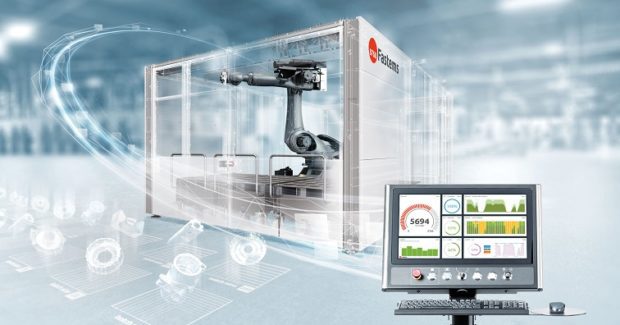Robotic Handling of Heavy Parts for Adaptable, Flexible Machining
The RoboCell One from Fastems handles heavy parts weighing up to 176 lb and automates up to two lathes or milling machines of the same type.
Posted: August 8, 2019
The RoboCell One from Fastems LLC (West Chester, OH) sets new standards in relation to extremely adaptable and flexible machining, particularly heavy workpieces within batches of different sizes. This easy-to-configure robot cell is primarily designed for handling heavy workpieces weighing up to 176 lb (80 kg) and for automating up to two machine tools of the same type – either lathes or milling machines. The system consequently comes into its own at the point where existing automation systems reach their limits solely due to the maximum weight of the workpiece. The RoboCell One has been specifically developed for the flexible production of different batch sizes including a wide variety of components. A special feature of the robot cell is an optional automated gripper change system for the flexible handling of workpieces and the simple implementation of new components – without interrupting production operations. The robot can accordingly be fitted with single, double, or special grippers. Up to six different grippers may be used for handling workpieces in specific production operations.
A single robot that can be operated in one linear axis is able to supply two machines with workpieces in a flexible manner. Further, different products can be simultaneously produced by using both machines together. To accomplish this scenario, the robot automatically changes its grippers for loading/unloading the respective unit. The result is optimal use of machine capacity, even when orders are frequently altered. Above all, through its use in combination with Manufacturing Management Software (MMS) for controlling the robot cell and the machines that are connected to it, RoboCell One provides virtually unrivalled advantages for production operations. MMS automatically plans the entire production process based on the production orders, including the changes of workpieces for batches of different sizes, and taking account of all the resources that are needed. The software also shows the current production status in real-time (order progress, schedule, etc.), calculates machinery capacities for outstanding orders and shows the operator in advance the machinery retooling operations that are needed – not only are production costs per workpiece reduced, throughput times are also cut thanks to this anticipatory detailed planning.
When the RoboCell One is first switched to the production of a new workpiece, virtually no knowledge of robotics is required. This greatly simplifies production, especially in the case of groups of components. Instead of the robot having to be laboriously taught, it is configured through parametric programming via MMS. The necessary values and/or parameters for workpiece handling are stored in the control system via the intuitive MMS interface. This means that new parts master data and orders can be produced both quickly and simply during production operations, i.e. while the machine is actually running. Another major benefit of this type of versatile productivity is the option of incorporating additional processes, such as a measuring machine or a marking system, within the automation system.
Fastems LLC, 9850 Windisch Road, West Chester, OH 45069, 513-779-4614, Fax: 513-779-4638, www.fastems.com.















